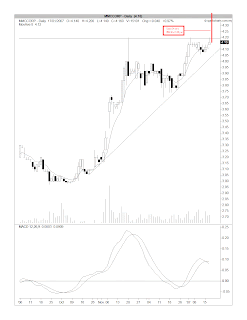Background
Ancom & its subsidiary, Nylex are both listed on Bursa Malaysia. Yesterday, they have both reported very good results for the QE 30/11/2006. The substantially better performance is attributable to the incorporation of the results of a recently acquired subsidiary, CKG Chemicals Pte Ltd ("CKG") which has led to a 80% increase in its turnover & 20% increase in its net profit. Nylex has completed its acquisition of CKG in September 2006 at a cost of S$40 million.
Recent Financial Results
Nylex's net profit has increased by 295% q-o-q or 455% y-o-y to RM20.6 mil. This was achieved on the back of a turnover of RM429 mil, which has increased by 124% q-o-q or 157% y-o-y. The much-better net profit is due to two reasons; firstly,
an amount of RM5.66 mil being dividend income from the Group’s investment in an unquoted company, and, secondly, profit contribution from CKG of about RM5.0 mil.  Nylex's last 8 quarters' results
Nylex's last 8 quarters' resultsAncom has similarly enjoyed a jump in its bottomline & topline. When compared to the preceding quarter, Ancom's net profit has increased by 14-fold to RM16.4 mil while its turnover has gained 69% to RM573 mil. The improvement is even more favorable when compared to the previous corresponding quarter when it incurred a net loss of RM1.1 mil on the back of a turnover of RM296 mil. The improvement is attributable to improvement in Nylex.
 Ancom's last 8 quarters' results
Ancom's last 8 quarters' resultsValuation
For Nylex, I shall assume that the dividend income of RM5.66 mil for the current quarter is a one-off event. If we exclude this item and annualize Nylex's current quarter's net profit, we can expect Nylex to make a net profit of about RM60 mil for a full year. Divided by a share capital of 194.338 million share, its EPS is about 30.1 sen.
For Ancom, I shall just annualize its current quarter's net profit to arrive at a full-year profit of about RM64 mil. Divided by its share capital of 201.857 million shares, its EPS is about 31.7 sen.
Based on the closing price at the end of the morning session, Ancom (closed at RM0.805) is now trading at a PE of 2.7 times while Nylex (closed at RM1.80) is trading at a PE of 6.0 times. As such, Ancom looks very cheap while Nylex's valuation is not demanding.
Technical Outlook
As expected, Nylex's share price has already begun to factor in the improvement in its financial performance. This cannot be said about Ancom's share performance. Ancom's share price is range-bound between RM0.62 & RM0.80. A convincing breakout above RM0.80 could signal the beginning of the rise in Ancom share price. This morning, Ancom's share price went to a high of RM0.84 before closing at RM0.805. If it stay above the RM0.80 level, Ancom would have broken out of its trading range & can go higher.
 Chart 1: Ancom's weekly chart as at Jan 23
Chart 1: Ancom's weekly chart as at Jan 23

Chart 2: Nylex's weekly chart as at Jan 23Conclusion
Based on fairly attractive valuation, both Ancom & Nylex are good buys. With the possible breakout as witnessed this morning, Ancom could be moving higher from now. I would prefer Ancom to Nylex.
Note:
Ancom’s main businesses are grouped into Agricultural Chemicals, Logistics, Polymer and Engineering divisions while Nylex’s businesses are grouped into Agricultural Chemicals & Polymer divisions. Nylex is 56%-owned by Ancom. Besides Nylex, Ancom also has a 29%-stake in another listed company i.e. Tamco Corporate Holdings Bhd, which is involved in the design, manufacture, supply, installation & commissioning of switchgear equipment & systems for power distribution & motor control.

















































